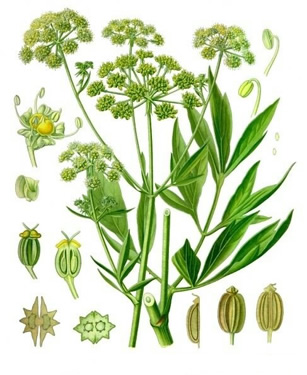Lovage
Lovage
Levisticum officinalis Koch.
Apiaceae Family
Description of Lovage
Lovage is a perennial herbaceous light-loving plant with fleshy, brownish-yellow rhizome (diameter 3–5 cm) and branched roots (up to 40 cm). In the first year forms rosette of large basal leaves, from the second year proceeds to flowering. Stem straight, hollow, grooved, 1–2 m tall, with bluish coating, branched upwards. Leaves shiny, broad-triangular, basal long-petioled (up to 70 cm), twice- or thrice-pinnate, 30–50 cm long, with obovate or rhombic incised lobes; stem small, short-petioled; upper sessile with expanded sheaths. Flowers small, light yellow, five-membered, gathered in complex 6–15-ray umbels (10–12 cm). Fruit yellowish-brown, oval-elliptical, ten-ribbed visianka, 5–7 mm long, 3–4 mm wide. Flowering in June–August, fruiting in August–September. Propagated by seeds, division of bush, root cuttings. Varieties: ‘Hercules’, ‘Don Juan’, ‘Udalets’. Aroma spicy, celery-like.
Distribution and Ecology of Lovage
Lovage originates from mountains of Southern Europe and Central Asia (southern Iran, Afghanistan). Cultivated in Europe (Russia, Ukraine, up to Moscow), North America, Asia. Prefers loose, fertile, deep soils with groundwater (pH 6.0–7.0), moderate humidity, temperature 15–25 °C, withstands frosts to -30 °C. Propagated by seeds (sow in March–April or October) or bush division. Yield: roots 2–3 kg/m², leaves 1–2 kg/m². Care: watering (5–10 L/m² every 7–10 days), nitrogen and potassium feeding (20–30 g/m²), loosening, protection from aphids and carrot fly. Grown in gardens, vegetable plots, rarely in greenhouses. Ecologically improves soil, attracts pollinators, but requires crop rotation.
Raw Materials from Lovage
Raw materials: roots (radix Levistici), herb (herba Levistici), fruits (fructus Levistici). Roots harvested in autumn (2–4th year, September–October), washed, dried at 35–40 °C (yield 15–20%). Herb and leaves collected in June–August, dried at 30–40 °C (yield 10–15%). Fruits collected in August–September, dried at 30–35 °C (yield 20–25%). Quality: roots brown, mold-free; herb green; fruits yellowish-brown, moisture <10%. Store in airtight containers lined with paper (roots: 2 years, herb and fruits: 1 year). Aroma spicy, celery-like.
Chemical Composition of Lovage
Roots: essential oil (0.6–1%, terpineol, cineole, butylidenephthalide, carvacrol, sesquiterpenes), furanocoumarins (psoralen, bergapten), organic acids (angelic, malic), resins, tannins, gum. Leaves: essential oil (0.05–0.1%), ascorbic acid (up to 118 mg%), carotene (5.3 mg%). Fruits: essential oil (0.8–1.4%). Calorie content: roots 20–25 kcal/100 g, leaves 15–20 kcal/100 g.
Effects and Applications of Lovage
Essential oil provides antiseptic, diuretic, choleretic, carminative, expectorant, sedative effects. Lovage improves appetite, intestinal peristalsis, blood circulation, reduces shortness of breath, has blood-purifying, mild analgesic effect. Used for edema, flatulence, constipation, chronic cholecystitis, kidney and liver diseases, gout, rheumatism, anemia, irregular menstruation, algomenorrhea, obesity, skin rashes, asthenic condition, circulatory insufficiency stages I–II, bronchitis. Externally decoction of roots and herb used for baths, lotions for abscesses, eczema, hair loss; leaves for poultices.
Precautions for Using Lovage
Raw roots before flowering toxic due to furanocoumarins. Dosage: infusions ≤200 ml/day, powder ≤2 g/day, juice ≤30 ml/day. Excess (>50 g/day roots, >50 ml/day tincture) causes nausea, dizziness, increased pelvic blood flow. Furanocoumarins increase skin photosensitivity. Store raw materials at humidity <10%. Give children under 3 years ≤5 g/day leaves. Do not combine with photosensitizing drugs.
Contraindications for Using Lovage
Pregnancy (abortifacient effect), acute nephritis, glomerulonephritis, allergy to Apiaceae, children under 1 year.
Recipes with Lovage
- Infusion for Flatulence. Pour 5 g roots with 200 ml boiling water, infuse 1 h, drink 50 ml 3 times a day, 7 days.
- Decoction for Edema. Boil 15 g roots in 500 ml water 10 min, drink 100 ml 3 times a day, 10 days.
- Tincture for Cholecystitis. Infuse 20 g roots in 500 ml 40% ethanol 14 days, drink 20 ml 2 times a day, 14 days.
- Infusion for Menstrual Disorders. Pour 7.5 g roots with 180 ml boiling water, infuse 1 h, drink 60 ml 3 times a day, 7 days.
- Powder for Rheumatism. Mix 1 g root powder with 10 g honey, take 2 times a day, 10 days.
- Infusion for Neuroses. Pour 5 g roots with 200 ml boiling water, infuse 30 min, drink 50 ml 2 times a day, 7 days.
Cosmetics from Lovage
Decoctions and infusions of lovage used to strengthen hair, treat skin and remove pigment spots.
- Infusion for Hair. Pour 10 g roots with 200 ml boiling water, infuse 15 min, rinse hair, 2 times a week.
- Lotion for Eczema. Pour 15 g herb with 300 ml boiling water, infuse 1 h, wipe skin, 1 time a day.
- Face Mask. 10 ml leaf juice, 10 g honey, apply for 10 min, rinse, 1 time a week.
- Bath for Psoriasis. Boil 30 g roots in 1 L water 10 min, add to bath, take 15 min, 1 time a week.
Culinary Uses of Lovage
Lovage adds spicy, celery taste, used fresh, dried, ground. Applied in salads, soups, sauces, meat dishes, marinades, preserves, teas, liqueurs. Young stems candied like candied fruits, roots in salads, soups, casseroles.
- Salad with Lovage. 20 g leaves, 100 g carrots, 50 g apples, 20 ml oil, mix, season with salt.
- Soup with Lovage. 10 g leaves, 200 g potatoes, 1 L broth, cook 15 min, serve with herbs.
- Tea from Roots. Boil 5 g roots in 200 ml water 5 min, drink with honey, 1 time a day.
- Marinade. 10 g leaves, 30 ml vinegar, 10 g spices, marinate meat 2 h.
Tips: Use young leaves for soft taste, sprinkle roots with lemon juice when cutting. For 1 kg leaves take 200 g salt for preservation. Combine with parsley, chives, thyme.
Other Properties of Lovage
Honey plant, attracts bees. In veterinary medicine fresh leaves applied to ulcers or given powder internally (15–25 g). Essential oil used in perfumery and culinary.




